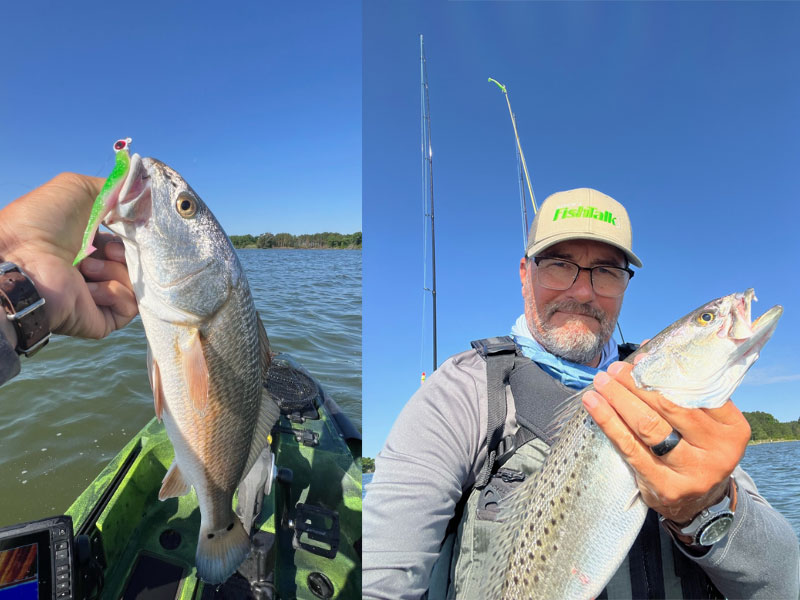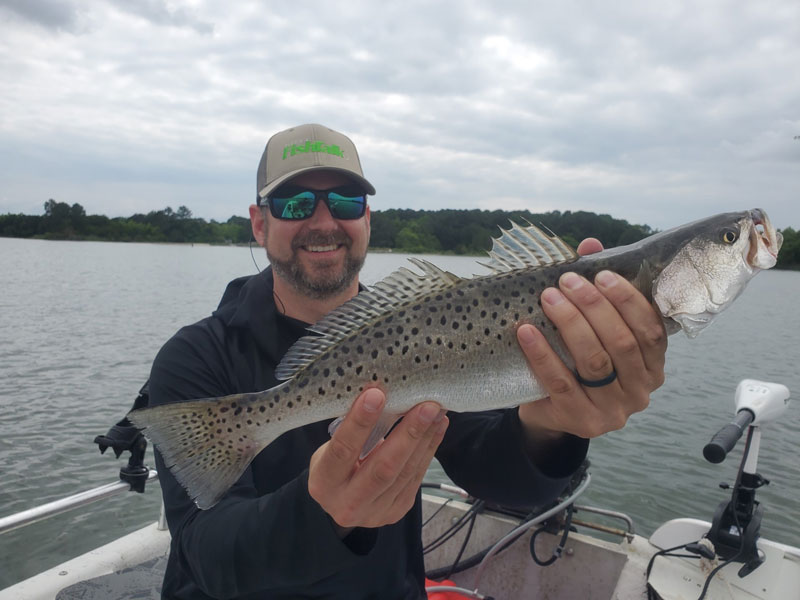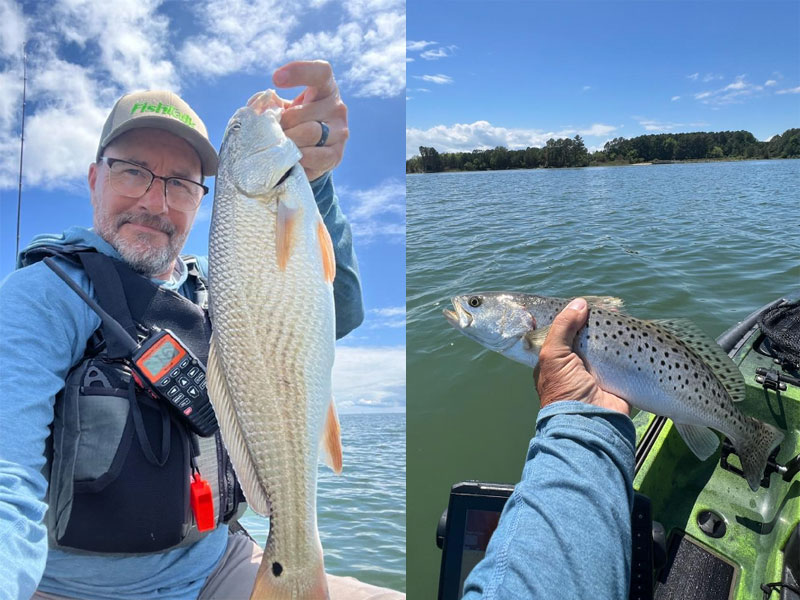Lower Chesapeake Bay Fishing Report, May 31 Update:
The start of the striped bass season on the Potomac is going well for many anglers. Boats trolling along channel edges from the 301 bridge down to the mouth of the river are picking up a mix of under slot and slot sized fish. One boat mentioned catching four keepers up to 24 inches while trolling small sassy shads. Reports of flounder are also a welcomed sight this early in the year as a few have been caught at the mouth of the river. One angler let us know that creek mouths in five foot of water produced small flounder in the 12- to 16-inch range while throwing a three-inch paddletail Further upriver, big blue catfish are still keeping anglers entertained. Light tackle guide Chad Koenig of Dog Days Fishing wrapped up his D.C. trips last week which concluded with an awesome mixed bag while jigging. He and his crew were able to catch around a dozen stripers, two quillback carpsuckers, a few white perch, a dozen flathead catfish up to 25 pounds, and around 30 blue catfish up to 40 pounds. All fish were caught using artificial soft plastics on light jigheads. There are some very big catfish hanging around this section of the river and an angler fishing in the vicinity of Fletchers Cove hooked into one this week. While fishing with cut perch, they caught a 50-inch, 69-pound blue cat that is one of the biggest we have seen caught on the river.

To the south in Virginia, an angler fishing the Piankatank found a good mix of fish this week with bluefish, white perch, striped bass, red drum, and speckled trout all making a showing. The biggest striper was 22 inches, biggest drum was 17 inches, and biggest trout was 19 inches. Most of their fish were caught fishing structure next to ledges. Small paddletails were the hot bait of the day. They also noted that they saw Spanish mackerel jumping out of the water near the bridge that goes over the river. Over on the Rappahannock the fishing at the mouth of the river is heating up in the shallows. A boat fishing with artificial lures on three to five feet of water caught a mix of keeper speckled trout, stripers, and red drum during an evening trip. One of the trout was citation sized and just goes to show that the Chesapeake Bay is one of the best speckled trout fisheries on the East Coast.
Crabbing Report: A reader hit the St. Mary’s over the weekend to try their luck at crabbing for the first time of the year. They used a kayak and 20 drop traps baited with white perch heads and managed to catch a bushel of crabs in a few hours of work. Despite the recent full moon, they said most of the crabs were dark and heavy. Most of the crabs came out of four to eight feet of water. Over in Bushwood, a commercial trot liner hit the Wicomico River late last week and said a full morning of crabbing on back-to-back days produced three bushels each day. Most of the crabs were number twos, but there was a mix of big crabs mixed in.
Lower Chesapeake Bay Fishing Report, May 24 Update:
The Chesapeake is filling up with many of our favorite species as we inch closer to sweet summertime. Angler in Chief Lenny Rudow reports that hunting for redfish and specks in creeks off the lower Potomac provided some action last weekend, but in a very limited bite window. A late morning and full afternoon of fishing consisted of five hours with very few tepid nibbles, and an hour and a half of hot action at the end of the outgoing tide with several under-slot reds (and two that looked to be keepers but pulled the hook at the boat—d’oh!), three keeper specks, and a slot striper. Contributor Eric Packard was fishing the same area before pulling up stakes and hitting Point Lookout, and had a similar experience with his fish hitting during an identical timeframe. A three-inch pumpkinseed paddletail with a lime green tail on a half-ounce head was a hot bait.

A reader checked in from the Smith Point area with a couple of specks, but more impressively, a 19” flounder – the northernmost keeper flattie we’ve heard of yet this year (congrats, Steve!!). On a return trip a few days later he landed more specks, all nice fish in the 20-inch range. As has been the theme this year, our migratory fish seem to be arriving earlier than expected and pushing north of their normal areas for this time of year. The first reports of bluefish have even started to roll in. Two anglers reported catching a few early season blues near Smith Point while throwing soft plastics in the shallows, and a reader encountered bluefish in the Wolf Trap area. Spanish mackerel are already showing up at the mouth of the Bay, so if the pattern continues, some may start to push into the Lower Bay in the coming weeks. A report came in from the Great Wicomico of good action on striped bass in four to seven feet of water along the outside edges of grass beds. Working the southern shoreline of the main stem of the river with paddletails produced steady action. The shallow water bite should continue to improve as water temperatures continue to rise, and more migratory fish move up the Bay.
Lower Chesapeake Bay Fishing Report, May 17 Update:
The big news this week for anglers is the opening of striped bass season in the Potomac River and in the Chesapeake Bay for both Mayland and Virginia. Anglers will be allowed to keep one fish per day within a slot of 19 to 24 inches. The shallows seem to have a lot of stripers in them right now as we have heard from those looking for early season speckled trout that they are finding many more rockfish willing to bite their lures. The Tackle Box is reporting good numbers of rockfish are in the Potomac, along with redfish at the creek mouths of tributaries. Contributor Eric Packard confirms the report, adding that he encountered some specks as well as reds, plus a few rockfish, fishing on the river midweek while casting silver-gray paddletails. Another angler fishing on the Virginia side of the lower Potomac reported that they have been catching some red drum up to 18 inches from their pier using shrimp on bottom rigs. The Tackle Box also noted that plenty of catfish are biting hard throughout the river, and that although the white perch bite was off after the last chill-down, they should pick the pace back up thanks to the warming weather.

As we progress through the spring, flounder are moving up the Bay into various tributaries. The days of going out and consistently catching big keeper flounder are long gone, but there are certainly plenty in the Lower Bay to target. Be ready for a lot of them to be undersized, but the grind will be worth it to catch a keeper. One angler reported in after searching for flounder around Gwynn Island, Virginia. They managed to catch four fish, the largest being 16.5 inches. The fish were caught on a ledge in 15 feet of water. As the water temperatures rise, flounder will begin to move into shallower water. Drifting bucktails tipped with Gulp! baits, squid, or minnows can be very effective. The minimum size for flounder in the Chesapeake Bay is 16 inches until May 31st. From June 1st until December 31st, the minimum size bumps up to 17.5 inches. A popular way to catch bigger flounder is to use live spot as bait. The spot are now being caught all over the Lower Bay and can be found in areas with shoals or oyster bottom. Bottom rigs baited with Fishbites, bloodworms, or lug worms will be the best setup to use when bottom fishing. A three or four inch spot is hard to resist for a big flounder, give it a try this season.
Lower Chesapeake Bay Fishing Report, May 10 Update:
The bite in the Lower Bay seems to be cutting lose as warmer weather has many fish moving up the shores of the Chesapeake. Contributor Eric Packard reports that the redfish are officially on in the Lower Bay, catching a half dozen or so slot fish plus under-slots along with some specks on multiple days this week, in a tributary off the Potomac. Packard also found a nice striper bite at PLO, catching nine rockfish up to 30 inches while casting from his kayak. Unfortunately, there’s some bad news, too: cownose rays have arrived, and in a big way. We had multiple reports this week of the big beasts snagging jigs and eating baits, so they’re likely to be problematic for the foreseeable future.

Reports Editor Dillon Waters made the trek down to the Piankatank in the middle of the week to search for reds and specks. Despite low winds, water temps around 70 degrees, and clean water, he only managed to catch four striped bass. The biggest was 23 inches, all caught on a three-inch Z-Man Diezel Minnow. Fishing docks and grass beds produced very little action, but those cow nose rays were everywhere which could have messed up the bite. This trip seems to be an anomaly as many other anglers are finding a variety of fish in the shallows of the lower Bay tribs.
The shad run seems to be more or less a done deal on the Bay’s southern tribs from the Potomac down, and FishTalk Intern Adam Greenberg visited Fletcher’s this week and found blue cats. We did hear from a worker at Fletchers Cove that water flows on the river bumped up early in the week which sparked a decent bite on American shad. Getting out away from the banks and fishing the deeper holes is the best way to catch the ones that remain. We also heard that there was a good schoolie striped bass bite in the Fletchers area early in the week and one angler caught over two dozen rock up to 22 inches while jigging. As more rain is in the forecast, it might improve conditions again to spark another bite for a few days.
Lower Chesapeake Bay Fishing Report, May 3 Update:
The Tackle Box checked in to let us know that plenty of catfish are being caught in the Potomac River. They are biting on a variety of baits like alewife, gizzard shad, perch, and just about anything else edible. Michael Whiffen of District Catfish says that the blue cats are pushing into shallower water and staying there throughout the day. He was out last week and caught over 200 pounds of blue catfish in the shallows near Three Sisters Island in one trip. We also heard from a reader who scored a nice catch of seven- to 10-pound cats fishing near Coles Point. On the upper Potomac near Fletchers Cove, flathead catfish are also attracting anglers to the area. This species is invasive too, and they are growing in size and number every year. Flatheads are a predatory fish and most anglers take the approach of jigging for them with soft plastics along the rocky ledges in the river. Five- and 10-pound fish are common, but flatheads as big as 40 pounds have been caught on the upper Potomac.

Shad fishing is slowing down with low flows and warming waters. There are still some hickory shad around along with some big Americans. The schools are thinning, and most will move out in the coming weeks. Contributor Eric Packard said a day at Fletcher’s produced just a handful of shad plus some blueback herring so if you want to catch shad before they are gone, don’t wait.
Migratory saltwater species are pushing further north into the Lower Bay this week. Speckled trout and puppy drum have been in the Rappahannock and Piankatank and they are pushing into the Potomac with the warmer weather. A pound netter in Cornfield Harbor reported that he found a 35-pound red drum and some big specks in his net last weekend. Spot are also starting to show up and the puppy drum should be right behind them as long as the warmer weather holds. An angler fishing in the Pianktatank last weekend found steady pickings of puppy drum and small speckled trout while fishing docks and rip-rap shoreline in various creeks. Four-inch paddletails were the ticket. Aquatic grasses are emerging more in the shallows and now that water temps are in the low 60s, bait and gamefish will be moving into these areas. Popping corks can be very effective when fishing shallow grass beds. The cork mimics baitfish being chased when popped correctly and will draw nearby fish in to check out the commotion. Give them a try the next time you are out.